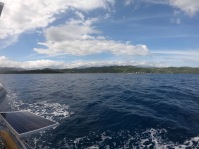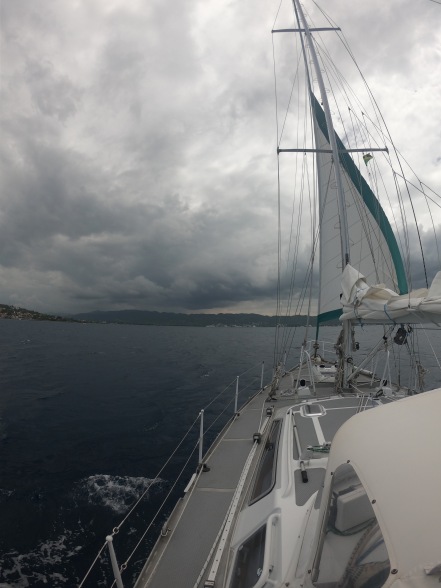April 9 – 18, 2019
One of the rather convoluted, confusing, conflicting, contradictory and oftentimes seemingly fluid challenges to navigate through in every new country we visit, are the policies and procedures of Customs and Immigration.
Fortunately, cruising guides specific to certain areas, websites (like noonsite.com), online forums, and even people at anchor around you are all great sources of information to make things simpler, or at least more digestible.
Clearing into a country with all the proper documentation in hand, forms filled out, questions answered, and procedures followed is the first process.
Moving around within the country sometimes can have some confusing procedures as well.
Such is the case with Jamaica.
Upon arrival, we have to clear into Jamaica at a Port of Call – Port Antonio in our case.
However, at that time we also have to declare the port that we are going to be clearing out of Jamaica from. Montego Bay, also a Port of Call on the northwest side of the island, is the typical place cruisers use.
To make it even more complicated, before departing Port Antonio, we are required to obtain written authorization to clear out of Port Antonio (just the town, not Jamaica itself). When we reach Montego Bay, we have to clear into Montego Bay (local clearance, because we’ve already cleared into Jamaica). Then, prior to departing Montego Bay, we have to clear out once again (this time to leave Jamaica).
If, for some reason, we turned around and returned to Montego Bay, we’d have to go through the whole process again.
Between the Port of Entry and Port of Exit it becomes even more convoluted. Our cruising permit is technically from Port Antonio to Montego Bay. We were instructed that if we wanted to anchor somewhere along the way (which seems only natural since our cruising permit is for three months), to simply inform the local port authorities that we were too tired to continue.
We interpreted this to mean that, while local authorities did not have Customs and Immigration officials to clear you in or out of the country, they still wanted to be informed of your arrival and departure in that area.
Confused? We were getting quite so.
In practice, aside from clearing both in and out of Port Antonio and Montego Bay, no one seemed to either notice or care.
The fact is that, in the hundred mile stretch between Porti and Mobay (as they are locally referred to), there are only a handful of potential anchorages, and some of those are tenable in fair weather only.
A lack of any protected bay, thirty foot or more depths nearly right up to the shoreline, rocks, coral, weeds, moorings or fish trap markers on the surface occupying space… any of a number of things can make an area unsuitable to anchor in.
An area with at least a patch of sand for a good anchor hold, room to swing, and depths between five and twenty feet can still be unsuitable if a mean swell can get to you or, even worse, another boat has already found it before you… damn!
Largely, it was hard to tell whether an anchorage was going to work for us until we got there.
The one thing we did know for sure was that, at twenty eight bucks a day to anchor in Port Antonio’s West Bay, the time to move on was quickly approaching.
And so, after getting clearance from Immigration, we picked up anchor and departed Port Antonio, managing to sail nearly seventy five percent of the time as we slowly worked our way along the northern coast of Jamaica.
Oracabessa
Our first anchorage, approximately thirty five nautical miles west of Port Antonio, was Oracabessa. Unfortunately, the tiny bay designated as an anchorage was already chock full of boats by the time we arrived.
Tentatively, we nosed in. However, twenty knot winds on our beam threatened to push us sideways in a very tight space, including the narrow entrance to the bay itself. We quickly realized that, though we might be able to squeeze in, it was better to abort and get the hell out to find more space… possibly flashbacks to our dragging fiasco in Back Creek, Maryland.
We settled for the wide open bay just outside. Not identified as an anchorage on our charts. Rolly as hell, too. But lots of space… and that was the important thing.
This was where we first encountered a friendly group of boats that had loosely hooked up together and were all heading in the same general direction as us. Two cruising boats with kids aboard, S/V Andromede and S/V Piper, as well as S/V Barefoot Two and S/V Grace. As we worked our was along the northern coast of Jamaica, oftentimes we would find ourselves in the same anchorages as these guys.
Continuing onward from Oracabessa, we were a bit uncertain as to where we would be best off dropping the hook next.
Ocho Rios
Mid-afternoon, the first and only time it happened while we were traveling along the coast of Jamaica, we were approached by the Jamaican Coast Guard while under sail. Conditions were quite boisterous so a boarding seemed unlikely. Instead, they hailed us on the radio to ask our last port of departure and our destination, came within about a thousand feet of us, and then wished us a nice afternoon.
Ocho Rios was our first attempt. Threading our way around the massive cruise ship dock in near twenty knot winds put us in a bay that seemed to have very limited space left for anchoring between other boats and mooring balls.
We thought we’d found a viable spot and had even backed down on the anchor. However, as the wind swung us around, our anchor, which was obviously not set as well as we thought, broke free and we started drifting perilously close to the giant cement pilings next to the cruise ship dock. When the anchor came up with a big clump of sea grass embedded in the tip, we knew why we had not properly set (though our Rocna anchor generally does a stellar job of grabbing the bottom, grassy bottoms can prevent it from digging in deep enough, and a clinging clump of grass keeps the tip from reseting should it drag).
With the very limited space and winds, we instantly said, “Screw this.” Best to keep moving.
Discovery Bay
The wind had picked up from twenty knots and was now hovering around twenty five. Saint Ann was the next option, but conditions were simply too rough to even go in.
Which put us to Discovery Bay, realistically our last option before sunset.
As we approached the anchorage area, we were hailed by S/V Barefoot Two on the VHF (they had left Oracabessa a day earlier than us) and warned to be cautious about our anchor set as there was lots of grass on the bottom everywhere and only small patches of sand; boats had dragged the night before… great.
Inside the bay, the wind had thankfully settled slightly.
Nevertheless, we managed to set yet another record for anchoring attempts required to get a proper set.
After seventy frustrating minutes and an excruciating seven attempts in various locations, we finally managed to get the anchor properly dug in… I believe we doubled down on our anchor beers that afternoon.
By comparison, Discovery Bay seemed the antithesis of Port Antonio. Though we stayed there for five nights, it was not what we would describe as a prime location.
The far side of the bay was occupied by a massive bauxite plant owned by Kaiser, which provides the U.S. with over two million tons of bauxite every year.
And, although The Cruising Guide to The Northwest Caribbean indicates that Kaiser “does a lot for the local community”, we found the three most notable impacts to be:
1 – An all encompassing red dust from the bauxite that permanently covers the foliage around the bauxite loading area (thankfully, we were generally upwind from the dock)
2 – An undetermined amount of damage from a bauxite hauling tanker we watched run aground on the reef alongside the channel that had to be pulled free by a tugboat.

3 – A Kaiser owned and operated “fun park” which imprisons dolphins, sharks, and stingrays (as well as a donkey and camel, of all things). Visitors who pay enough money are provided with a photo of their encounter… visitors who pay even more are allowed to touch the prisoners… those who cough up enough money are apparently allowed to ride the dolphins…
… not sure how this “fun park” is a necessity for the mining and transport of bauxite.
… not sure how this “fun park” contributes to the betterment of the local community.
… pretty sure this “fun park” makes a shit-ton of money for Kaiser.
… absolutely positive that this pathetic money grubbing endeavor (or “fun park”) exploits and harms marine life purely for the sake of profit.
Apparently, this is the kind of thing that cruise ship guests want… which is why I would never be caught dead on a cruise ship.
I apologize to all cruise ship guests who have formally contacted the activities directors and/or dolphin encounter facilities and informed them they would not do business with anyone who promoted and supported such exploitative practices…
I’m pretty sure both of those cruise ship guests will forgive me…
Anyway… Discovery Bay… not our favorite place.

And, while disheartening to learn of Jamaica’s tolerance of captive dolphin and marine animal industries, it was even more disheartening to learn that these exploitations are quite normal business practices throughout the Caribbean.
Both as divers and sailors, we are dependents of the oceans… we are stewards of the oceans… by necessity, we must be guardians of the oceans… apparently someone has to. Come to think of it, don’t we all?
Montego Bay
It became apparent that Port Antonio was our Jamaican highlight which we would be hard-pressed to surpass, or even match.
We decided it was time to head for Montego Bay.
Once again, we were grateful for the direction we were traveling. The minimum twenty to twenty five knot winds consistently over the six and a half hours we sailed would have been brutal going the other way. In fact, the gusts of thirty three knots we experienced near the end were the highest we have ever seen off anchor.
We entered the bay with only a tiny scrap of sail out, still making over seven knots of speed. Fortunately, on this day our anchor set perfectly on the first try after reaching Montego Bay.
We both concurred that the anchor beers were, once again, well earned.


















